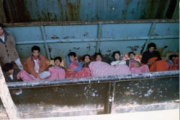The Fuzhounese
From The Peopling of NYC
Fuzhounese (aka Fujianese) immigration to New York began sometime during the 1940s. Since then the Fuzhounese population in New York has steadily grown and continues to do so. “Economic opportunities” as waiters and seamstresses plus reuniting with their families in the United States made immigration to New York highly appealing for the Fuzhounese. As a result, some have come legally through certain clauses in the immigration laws. Most Fuzhounese immigrants, however, came illegally with help from “snakeheads” and the extensive human smuggling network they ran.
According to Professor Kenneth Guest, author of God in Chinatown, the majority of Fuzhounese immigrants came to the United States during or after the 1980s. He classifies these immigrants into six contemporary waves, which is portrayed by the table below (taken from God in Chinatown).
Fuzhounese Immigrant History
| Arrival | Characteristics | US Legal Status |
| Before mid-1980's | Residence Outside of China prior to arrival in US | Legalization under 1986 IRCA |
| Mid-1980's to 1989 | Smuggled rural poor | Legalized under provisions of 1989 and 1990 executive orders |
| To Present | Young, smuggled | No legal status |
| To Present | Both urban and rural, all ages | Immigrated legally under 1965 INA, especially under family unification provisions |
| To Present | Children born and raised in U.S. | Legal by birth in U.S. |
| To Present | Children born in U.S., raised in China | Legal by birth in U.S. |
As stated before many Fuzhounese immigrants utilized human smuggling services offered by “snakeheads” to come illegally into the United States. These services often provided documents and transportation for those who wished to leave for the U.S. Some were smuggled to the U.S. directly by air transport, but as the air routes underwent greater surveillance, people were often smuggled by sea which was a longer and more uncomfortable journey. These services did not come with a cheap price tag. During the late 1980s the average smuggling fee was more than $20,000. This number grew to somewhere between $50,000 and $60,000 in 2002. Many immigrants who utilized the smuggling networks did not readily have the money to pay the smugglers and therefore accumulated a large amount of debt, which they would have to pay back with interest that was sometimes as great as 25% annually. Nevertheless, the consequences of not paying off their debt were much worse. For those unable to pay, they may have been beaten, their families may have been extorted, or they may have been forced to serve the snakeheads in illegal activities. Yet many Fuzhounese found themselves cramped on cargo vessels hoping to achieve the “American Dream” regardless of the hardships they would face.
The opportunities that the Fuzhounese were chasing were those in the restaurant and garment industries. These were jobs that could require one to work over 12 hours a day and pay as little as $2 per hour with no benefits. So why then, did the Fuzhounese come to America only to work in such low paying jobs? The answer is because these miniscule wages were still larger than those offered in China. Unfortunately, because most Fuzhounese are not documented they cannot demand higher wages and better working conditions. These immigrants had to take whatever job they could find and these usually ended up being jobs as busboys or seamstresses. Sometimes the only jobs they could find were not even in New York but in other cities far away from their desired destination.
What makes the Fuzhounese immigrants intrinsically different from the other Chinese immigrants who came before them was the exploitation they often faced. Actually it is in fact their predecessors who are inflicting this exploitation upon them in many cases. In order for the Fuzhounese to achieve a higher standard of life than they would have in China they would have to pay obscene amounts of money to get to America only to find jobs that paid and offered so little. The only advantages that the Fuzhounese bring with them are their social capital, which unfortunately happens to be their ability to communicate with other Chinese. This forces them within the ethnic enclaves such as Chinatown. They do not have the skills to make it anywhere else and often they are not given the means to, considering the Restaurant and Garment Shop owners want to keep their low-wage workers. This all causes Chinatowns to be in many ways more of a trap than a stepping stone.
Sources
- God in Chinatown: Religion and Survival in New York's Evolving Immigrant Community by Kenneth Guest
- From Fujian to New York: Understanding the New Chinese Immigration
- Dying To Leave


